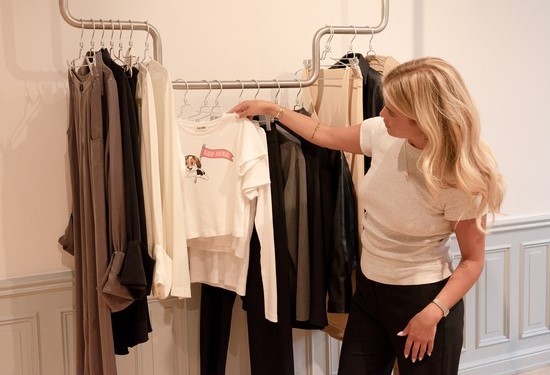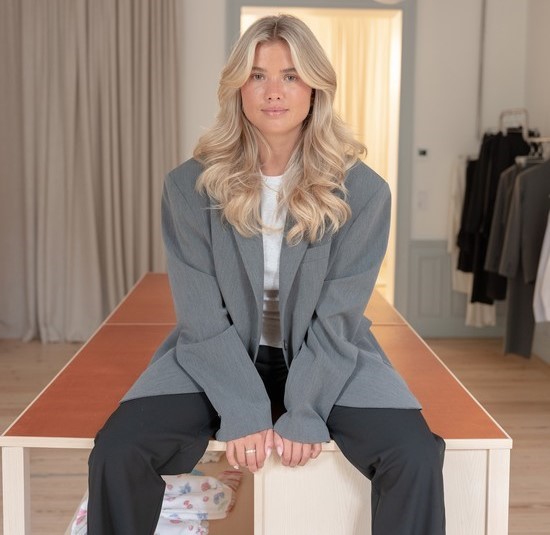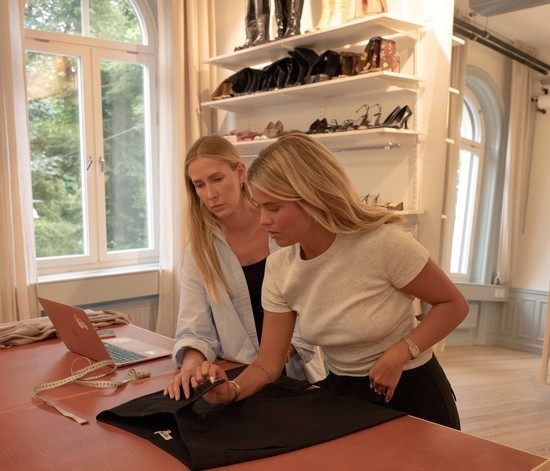STOCKHOLM — It was a gray summer’s day, but on the first floor
of a grand office block typically occupied by bankers and shipping brokers,
Matilda Djerf was basking in the glory of Midsommar.
اضافة اعلان
Djerf, a
25-year-old social media influencer who founded fashion brand Djerf Avenue with
her boyfriend, Rasmus Johansson, in 2019, has forged a fast-growing business
empire on tantalizing glimpses of her soft-focus Scandi dream life — not to
mention one of
TikTok’s most emulated haircuts. But last month, while in her
immaculate headquarters, all whitewashed walls and blond floors, there was not
a flower crown or embroidered frock in sight. Instead, she watched footage of a
group of girls nearly 9,700km away, in California, who had thrown a party
themed around the traditional Swedish celebration of the summer solstice in her
honor.
“We try to be more than a fashion brand,” said Djerf
(pronounced gerf). “We are just as focused on building a community.”
Tanned with rosebud lips and a ski-jump nose, she
wore diamond hoop earrings that bounced against her shaggy bangs as she
gestured to the screen. “We communicate with customers constantly on social
media,” she said. “Many of them find new friends through Djerf Avenue as well
as new clothes.”
 Matilda Djerf looks over designs for a new collection in her Stockholm showroom on July 27, 2022.
Matilda Djerf looks over designs for a new collection in her Stockholm showroom on July 27, 2022.
Djerf flicked through shots that would later be
uploaded to the brand’s Instagram account. The girls, in a range of shapes,
sizes and skin tones, beamed in sellout styles like the Dream Dress ($199) or
Tie Tank Tops ($119). Nearby, Djerf Avenue employees, identically dressed in
oversize poplin shirts and loosely tailored black slacks that mirrored Djerf’s
masculine-meets-feminine style, tapped away on laptops.
“A lot of customers apply to be models,” Djerf said.
“They are so loyal and so devoted. We call them our Djerf Angels. They love to
be part of our world.”
Or, more specifically, Matilda Djerf’s world. By
buying her clothes and emulating her lifestyle, a growing number of customers
believe they can be like Djerf.
Not that the extent of Djerf’s influence can fully
be gleaned from a list of easily digested numbers. She commands a following of
2.6 million on Instagram and 1 million on TikTok on her personal accounts.
Those are sizable social media metrics but a far cry from those of American
peers such as Addison Rae or Charli D’Amelio. She does not post often. Nor is
she the first influencer to create her own brand. What sets Djerf apart is the
devotion she engenders in her fans — and the way she and Johansson, chief
executive of Djerf Avenue, have leveraged her popularity to build a profitable
business with expected sales revenues of $22 million this year, up from $8
million in 2021.

One can scroll through tens of thousands of adoring
posts parroting her clothes, her poses, her blow-dry. Her name has been used as
a hashtag on TikTok 156 million times, and she regularly emerges as a face of
wider Gen Z fashion trends like “cottagecore”, “coastal grandmother”, and
“clean girl.” Even though she is not exactly any of those things.
“Matilda Djerf has this very tailored brand and
aesthetic that still feels candid and relatable,” said Chelsea Davignon, a
senior strategist focused on youth trends at forecasting agency Fashion Snoops,
who praised Djerf’s ability to master “the formula” across generations and
platforms. Especially for women who do
not look like her.
Only just out of reach
Djerf grew up about 400km
southwest of Stockholm in a small town called Boras, though she speaks perfect
English with an American twang thanks to two years in Monterey, California, as
a child. She and Johansson are high school sweethearts, and after graduating in
2016, they went backpacking in the
Caribbean, Bali, and Australia. She started
taking photographs of their travels — and Johansson took photos of her — which
she would then post on her fledgling Instagram account.

By the time they returned to Sweden in 2017, she had
100,000 followers.
By 2019, Djerf realized she did not want to do brand
partnerships or collaborations; she wanted her own brand, period. That
December, Djerf Avenue released an initial drop of nine pieces that Djerf felt
were missing from her own wardrobe. It sold out overnight.
Now, two and a half years on, Djerf Avenue produces
about 10 drops a year, with a logistics warehouse opening in the
US this fall
to better cater to its largest market. There are no sales or discounts. Ninety
percent of the company is jointly owned by Djerf and Johansson, though they
sold a 10 percent stake to an angel investor in April.
“What I wanted with Djerf Avenue was to give people
classic and comfortable staples that they can wear again and again or style in
multiple ways over years,” she said, pointing to an oversize caramel trench and
matching stretch tube skirt and top. Sizes for the collections range from XXS
to XXXL.

Under the democratizing forces of social media, the
range of skin tones, dress sizes, and backgrounds celebrated by the news media
has expanded considerably in recent years. Djerf, of course, is the embodiment
of the expensive-looking, blond-haired, blue-eyed girl-next-door aesthetic that
has long dominated conventional fashion and beauty standards. She may have
created a lifestyle blueprint around herself that can be commercialized for a
diverse audience and a platform through which like-minded women can interact
with one another, but the face of Djerf Avenue, the reason they come, is
ultimately her. It is not cheap to be part of her dream, either.
“I am not oblivious to the fact that I am in many ways
society’s ideal of what a perfect person looks like,” Djerf said. “I realize
how much privilege I have. … That life can be easier for me. … But that doesn’t
mean I don’t feel a strong sense of responsibility to do things the right way.”
Read more Fashion
Jordan News



